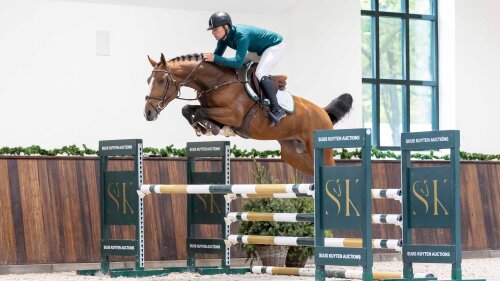At Spruce Meadows course designer, Leopoldo Palacios did built some exciting courses. "As a course designer, you have to consider a number of factors including the height and width of the fences, the time allowed, the layout of the course, the design of the fences, and the slope of the ring. It is important for us to focus on all aspects and ensure that a balance is achieved – this is what makes a good Grand Prix – and it is a balance that I think we have achieved here at Spruce Meadows."
Can you please explain your official role and what this entails?
I am the course designer here at Spruce Meadows, and I have been working here for over 25 years. To be a good course designer you need to have a lot of experience in the sport, and you need to be able to create brilliant competition through your courses. I have a fantastic team that helps me and ensures that we provide the best course possible.
To ensure that the level of the sport continues to grow, it is vital that the horses are looked after, and so it’s a fine line between what is achievable for the horses and riders and what will push the sport forward.
What is so special about the CSIO Spruce Meadows ‘Masters’ Tournament?
I consider Spruce Meadows to be my home, and I consider the Southern family to be my family. I have been working here for over 25 years and in my opinion, there is nowhere quite like it. The team is extremely special, and the level of detail and planning that goes into the event is incredibly impressive.
As a course designer, there can be a lot of pressure to build a great course that lives up to the standards of Spruce Meadows, but the team here places their trust and confidence in my work.
The CPKC ‘International’ Grand Prix, presented by Rolex at the CSIO Spruce Meadows ‘Masters’ Tournament is often considered to be one of the toughest courses in the world, what makes it so unique?
As a course designer, you have to consider a number of factors including the height and width of the fences, the time allowed, the layout of the course, the design of the fences, and the slope of the ring. It is important for us to focus on all aspects and ensure that a balance is achieved – this is what makes a good Grand Prix – and it is a balance that I think we have achieved here at Spruce Meadows.
We [course designers] can be compared to choreographers – we want to ensure that the class is a true spectacle for those who are watching. We try to get the balance right for everyone, from the horses and riders to the fans.
In the past, I have designed courses for the 2000 Olympic Games in Sydney and the 2008 Olympic Games in Beijing. In my opinion, the course for the CPKC ‘International’ Grand Prix, presented by Rolex, here in Spruce Meadows is bigger and harder than the Olympic courses.
Can you please give us some insight into the course?
It is a very testing course. In the first round, there will be 13 fences with one triple and double, and in the second round there are 12 fences with one triple and double again – it is a lot of jumping. The spreads and the height of the fences will be very big as well! Here at Spruce Meadows, we have a collection of fences that come from every Olympic Games and Major championship since 1974, so the course always looks amazing.
During the CPKC ‘International’ Grand Prix, presented by Rolex, here at Spruce Meadows ‘Masters’ Tournament, I use fences that have not been jumped during the previous classes for example; the double of Liverpool’s, the dry ditch and the water jump.
The Grand Prix is a different type of course from the Nations Cup course which is more classic. In my opinion, the CPKC ‘International’ is more demanding on the horses and riders, and the purpose of this class is to emphasise the impressive skills of the horse and rider combinations and provide great sport for the fans.
How important is it to have the best riders competing here at Spruce Meadows?
In this year’s edition of the CSIO Spruce Meadows ‘Masters’ Tournament, we have six out of the top 10 riders in the world competing. The event attracts the best in the world, and this allows me as the course designer to be creative when testing the level of the horse and riders. The course needs to be challenging, especially the second round. In the second round, the 12 best riders from the first round compete; they really are the crème de la crème of the sport, and with this level of talent, I can truly test them with my course.
The line that contains the double Liverpool will be challenging – it is a special feature for the CPKC ‘International’ Grand Prix, presented by Rolex, here at Spruce. Whilst I like to use this feature every year, I differ it slightly year on year. It is my job to come up with new and innovative ideas for the course each year – which is not easy!
The Rolex Grand Slam of Show Jumping is celebrating its 10th anniversary this year. How positive has it been?
I have seen a change over the last 10 years. Rolex has helped the sport exponentially – all of the best riders in the world aim to ride in these Majors. It is truly remarkable to have the world’s best riders competing to win these Majors.
At Spruce Meadows, we had the privilege of witnessing Scott Brash being the first and only rider to achieve the incredible feat of winning the Rolex Grand Slam of Show Jumping back in 2015. That was a such memorable and incredible day – it is something that I will never forget
The Rolex Grand Slam of Show Jumping has definitely added another level to the sport. In my opinion, there is nothing more important than the Rolex Grand Slam of Show Jumping in the sport.
Do you have a highlight in your career?
I have experienced a number of special moments in my career, but the one that stands out is when Scott Brash won the Rolex Grand Slam of Show Jumping here at Spruce Meadows in 2015. It was truly incredible – the audience and riders were all rooting for him and wanting him to win. The atmosphere that day was something I have never experienced before!
What advice would you give someone starting in the sport as a course designer?
My piece of advice is to love horses and to be truly passionate about what you do. You should always try to continue to learn about horsemanship as it helps you progress in the sport. I monitor the emotions of horses, analyse statistics, and observe what occurs during the show. You shouldn’t enter into this business in the hopes of being rich and successful, but you should enter for the love of the sport. It is my passion for the sport that has brought me here today.
source: Rolex Grand Slam / Ph. Ashley Neuhof



